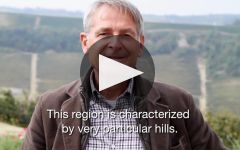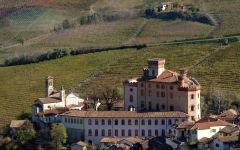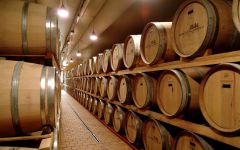Marchesi di Barolo Barolo Sarmassa 2012
-
Wine
Spectator -
James
Suckling -
Robert
Parker



Product Details
Your Rating
Somm Note
Winemaker Notes
It goes perfectly with the traditional egg pasta from the Langhe, Tajarin (Piedmont spaghetti) and ravioli al plin, with roasts, stews, braised meats and game. It ‘perfectly matched with cheese from goat’s milk and aged one.
Professional Ratings
-
Wine Spectator
This is opulent, boasting cherry, licorice, leather and spice flavors embraced by a fleshy texture. The sweet fruit carries through to the long finish, accented by tobacco, tea and wild herb notes. Best from 2020 through 2033.
-
James Suckling
Sarmassa cru made beautiful wines in 2012 and this is very aromatic with rose petal and raspberry aromas. Very subtle aromatically. Full-bodied, chewy and tannic, yet has a pretty dusty texture giving the wine a softness at the end with bright acidity. Better in 2020.
-
Robert Parker's Wine Advocate
The 2012 Barolo Sarmassa delivers a healthy quota of muscle and brawn. Despite its power, it also shows deep inner elegance that does not go unnoticed. This Barolo still needs time to find its footing and it requires five (or more years) of cellar aging before it reaches a better place of integration and balance. At this stage, it shows depth, austerity and a promising succession of dark fruit, cola, tar and toasted spice.
Other Vintages
2016-
James
Suckling -
Wine
Enthusiast -
Robert
Parker
-
Wine
Enthusiast -
Wilfred
Wong -
James
Suckling - Decanter
-
Robert
Parker -
Wine
Spectator
-
Robert
Parker -
James
Suckling -
Wine
Spectator
-
James
Suckling -
Robert
Parker - Decanter
-
Wine
Enthusiast -
Wine
Spectator
-
Wine
Enthusiast -
Robert
Parker -
James
Suckling -
Wine
Spectator
-
Robert
Parker -
Wine
Enthusiast -
James
Suckling -
Wine
Spectator
-
Robert
Parker -
Wine
Enthusiast -
James
Suckling
-
Wine
Enthusiast -
Robert
Parker -
Wine
Spectator
-
Wine
Enthusiast








The Marchesi di Barolo estate encompasses approximately 430 acres of vineyards in the Langhe, some of the finest in Piedmont, including the prestigious Cannubi cru. The cellars are in the village of Barolo, overlooking the Renaissance castle of the Marchesi Falletti di Barolo. Barolo as we know it today was first made in the early 19th century by the Marchese Carlo Tancredi Falletti di Barolo and his wife, Giulia. The wine from their estate soon became known as “the wine from Barolo”, served at important diplomatic and royal functions. The Marchesi had no children and following the death of the couple, the Marchesi di Barolo dynasty was left without an heir. Per the wishes of Marchesa Giulia, a great philanthropist, the family assets were donated to charity and a non-profit foundation was created in their name, “Opera Pia Barolo”, helping the needy of nearby Torino. The sales of wine from their Barolo vineyards continue to fund the charity, which still exists today. In 1929, local winemaker, Pietro Abbona purchased the cellars formerly owned by the Marchesi and eventually acquired all their vineyard holdings as well. Today, Marchesi di Barolo remains a family business. Since 2006, the estate has been under the direction of Pietro’s great-grandson and fifth-generation winemaker, Ernesto Abbona and his wife Anna, (with their children Valentina and Davide) who have inherited a longstanding winemaking tradition and a love of the vineyards and its wines..

Responsible for some of the most elegant and age-worthy wines in the world, Nebbiolo, named for the ubiquitous autumnal fog (called nebbia in Italian), is the star variety of northern Italy’s Piedmont region. Grown throughout the area, as well as in the neighboring Valle d’Aosta and Valtellina, it reaches its highest potential in the Piedmontese villages of Barolo, Barbaresco and Roero. Outside of Italy, growers are still very much in the experimentation stage but some success has been achieved in parts of California. Somm Secret—If you’re new to Nebbiolo, start with a charming, wallet-friendly, early-drinking Langhe Nebbiolo or Nebbiolo d'Alba.

The center of the production of the world’s most exclusive and age-worthy red wines made from Nebbiolo, the Barolo wine region includes five core townships: La Morra, Monforte d’Alba, Serralunga d’Alba, Castiglione Falletto and the Barolo village itself, as well as a few outlying villages. The landscape of Barolo, characterized by prominent and castle-topped hills, is full of history and romance centered on the Nebbiolo grape. Its wines, with the signature “tar and roses” aromas, have a deceptively light garnet color but full presence on the palate and plenty of tannins and acidity. In a well-made Barolo wine, one can expect to find complexity and good evolution with notes of, for example, strawberry, cherry, plum, leather, truffle, anise, fresh and dried herbs, tobacco and violets.
There are two predominant soil types here, which distinguish Barolo from the lesser surrounding areas. Compact and fertile Tortonian sandy marls define the vineyards farthest west and at higher elevations. Typically the Barolo wines coming from this side, from La Morra and Barolo, can be approachable relatively early on in their evolution and represent the “feminine” side of Barolo, often closer in style to Barbaresco with elegant perfume and fresh fruit.
On the eastern side of the Barolo wine region, Helvetian soils of compressed sandstone and chalks are less fertile, producing wines with intense body, power and structured tannins. This more “masculine” style comes from Monforte d’Alba and Serralunga d’Alba. The township of Castiglione Falletto covers a spine with both soil types.
The best Barolo wines need 10-15 years before they are ready to drink, and can further age for several decades.
